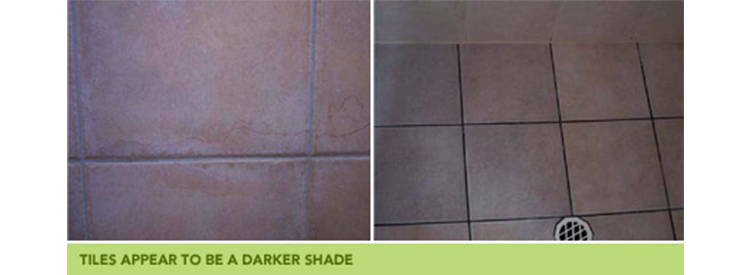
Simply put, tiles cannot change colour. Tiles are an inert product. They do not fade in sunlight and neither can they tan, or turn a darker shade.
If a tile is wet and is sitting in water, however, the biscuit of the tile can become wet. All tiles will absorb moisture to some degree, depending on the type of clay biscuit. And then, just like wet chalk, or a sponge, the biscuit will appear to be a darker colour or shade. If the glaze on a wet tile is white or a very light colour it tends to be translucent or see-through. The darker background biscuit will then make the tile look darker than other dry tiles.
In extreme cases, even when the tile has completely dried out, the biscuit will stain and the colour of the tile will appear to have changed somewhat.
Water absorption is the only way that a tile can appear to have changed colour. If water has penetrated behind the tile, or is caught behind the tile it will travel and soak into the biscuit of the tile.
Water can penetrate behind the tile through holes in the grout, missing grout, or poorly applied silicone joints. Especially, if there is a partly blocked drain and a slow draining waste and the silicone joint in the internal corners are not intact.
Or, if there is a leaky water pipe behind the wall.
Or, if the waterproofing system does not include a 'puddle flange' to remove trapped moisture between the tiles and waterproofing membrane on the floor.
This is why this situation usually manifests itself in a shower recess.
If you notice that the tiles in your wet area, especially in the shower recess have changed to a darker colour, the situation needs attention as soon as possible. It is an indication of a problem that can cause long term structural damage if left unattended.
It is not a problem with the tile, but the installation, or perhaps a serious water leak.
Call your builder or plumber to test for a leak in the water service.
They will also be able to advise if the waterproofing includes a puddle flange in the floor and, if the project is fairly new, explain why there is not one installed. Or it may be there, and the special built in gutter just needs cleaning out.
Check for any obvious visual faults or weak points in the grouting and silicone joints. If it appears suspect, remove the grout in the affected areas. Dry the tiles out slowly, using a fan heater on low. This should bring them back to normal appearance. Regrout the tiles using grout mixed with a 'booster.' Apply silicone to all corners in the shower.
Purchase and install special 'fluid aprons' as an added insurance around the tap penetrations.